Interview with Roy Dean
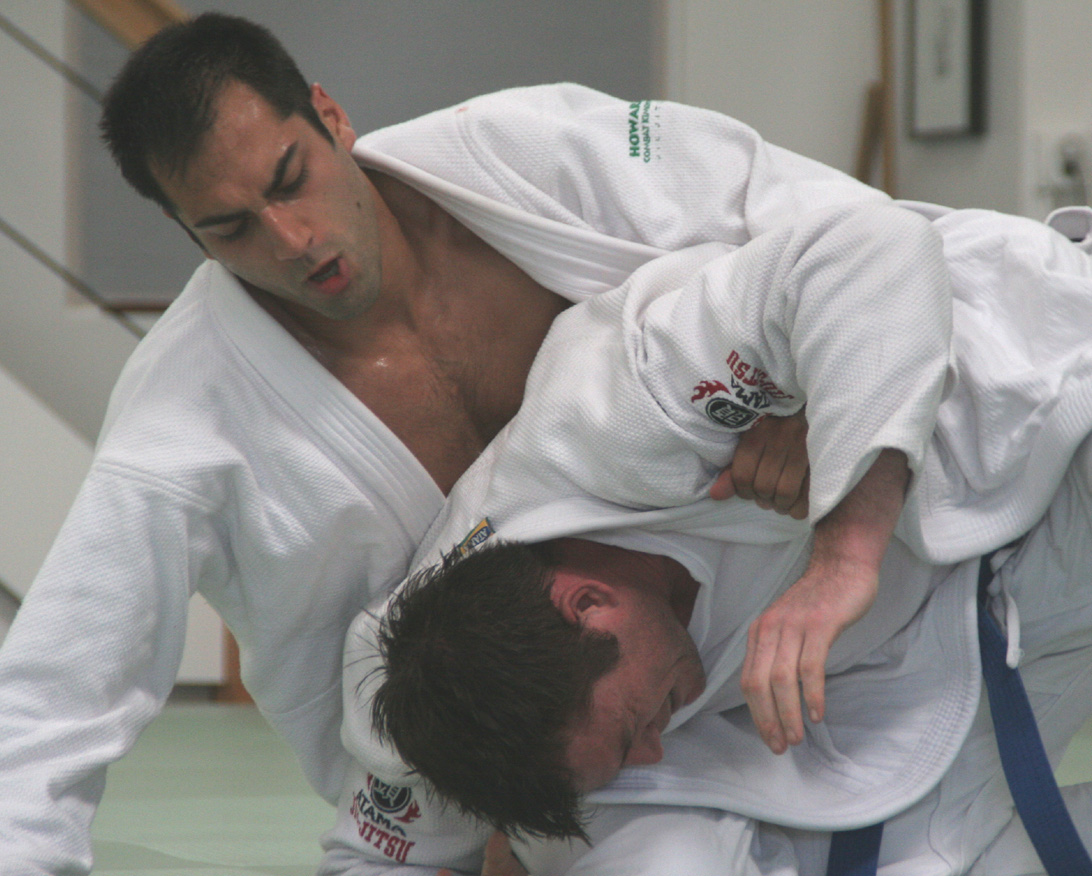
This month I have the great pleasure of sharing with you an interview with Brazilian Jiu-jitsu black belt, Roy Dean. Roy has been an avid martial artist since a young age and holds the rank of black belt in several arts including Kodokan Judo, Enshin Itto-Ryu Batto Jutsu, Aikikai Aikido, in Seibukan Jujutsu. I think you would agree Roy is likely good in a scrape!
Roy recently opened his school, the Roy Dean Academy in Bend, Oregon. I will be forever bitter he did not come to Chico, CA to set up shop, but I guess I will contain my hazing to the phone. Taunting BJJ black belts tends to get ones elbows twisted around in odd directions!
Check out Roy’s blog and near the end of the interview you will find out about a surprise Roy has for us that anyone with an interest in BJJ or martial arts in general will love.
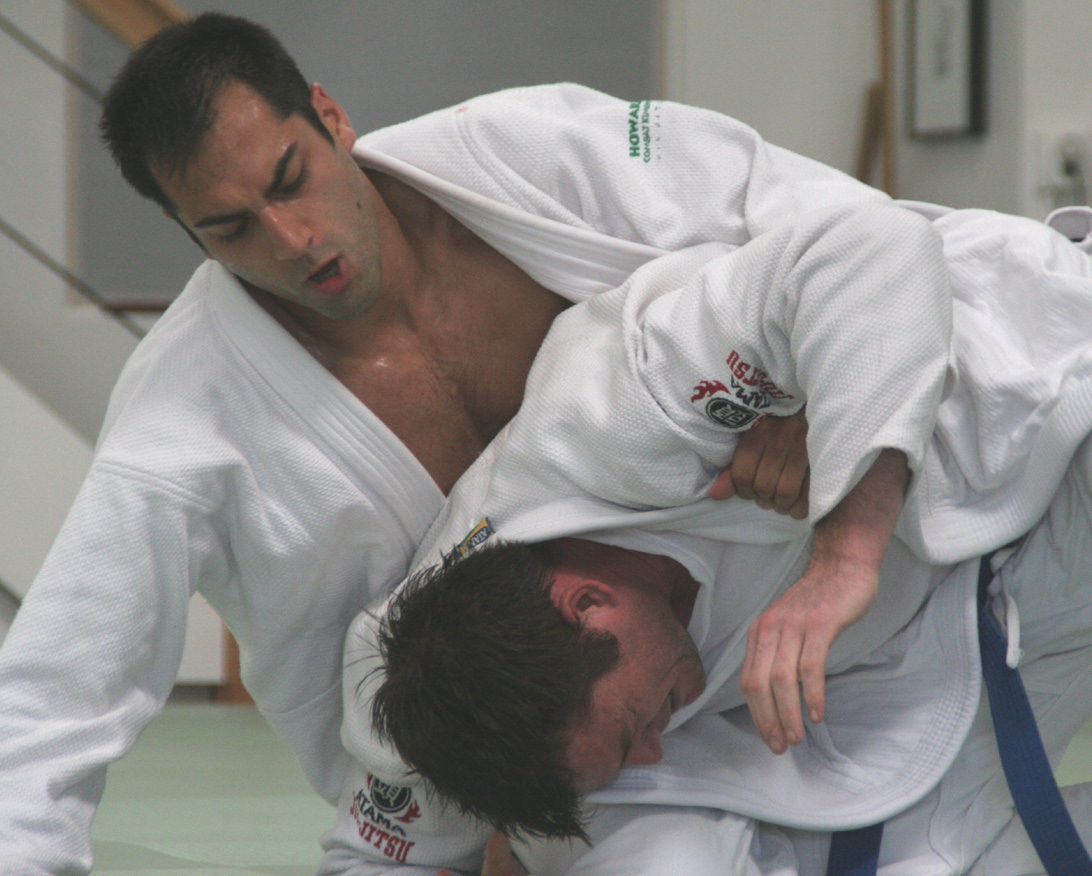
Photo: Alicia Anthony www.aliciaphotos.com
Hey Roy! Thank you again for granting the interview. Please tell the readers a little about yourself: where you grew up, sports you have participated in outside martial arts, school, music background, etc.
Thanks for giving me the opportunity! I grew up in Anchorage, Alaska, and never really integrated into group sports. I was more taken by playing piano as a child and young teenager. I did a little track, some cross country skiing, and weightlifting in high school, but downhill skiing was really my sport of choice until I went to Japan as an exchange student. That's when I began to study Judo.
Some years later, and after several martial arts adventures, I attended the University of California, San Diego. There I studied media arts, specializing in computer music. After graduation, I was hired by a video production company and became their lead audio engineer, mixing TV shows, high-end corporate presentations, commercials, and the like. It was a tremendous opportunity, and I was fortunate to work with some very talented individuals, as well as continue my studies in Brazilian Jiu Jitsu under Roy Harris. After four years of service, and with my BJJ black belt in hand, I decided to launch my own martial arts academy in Bend, Oregon.
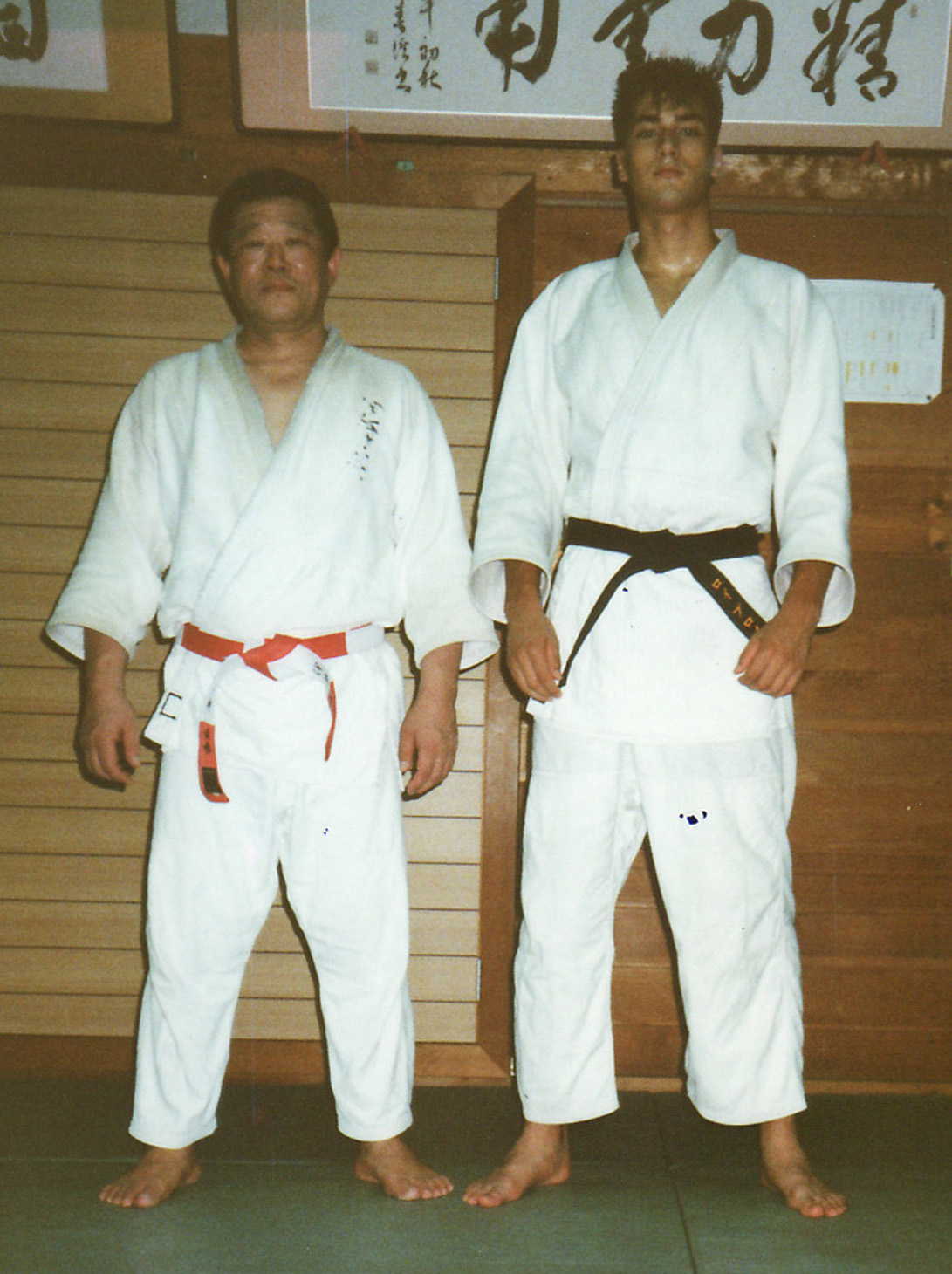
How did you begin training the martial arts? What drew you to your first art and how would you describe your journey from those first days to the present? Please describe the arts you hold rank in, what unique features they offer and what they contribute to your present game? Be wordy!
I was sixteen when I served as a Rotary exchange student, and while at my high school I was encouraged to study a Japanese art in their after school club program. Among my choices were Ikebana (flower arranging), Kyudo (Japanese archery), Kendo (sportive fencing), and Judo. Laden with testosterone, Judo was my first choice. They warned me that Judo training was very severe, but since I was having a rough enough time adjusting to the Japanese culture, I threw myself into learning the art.
I was able to fully invest myself in training while I was there. Not only because Judo was a cultural institution embedded in the social consciousness (much like football is over here), but also because I was in sensory overload and had to channel my energy somehow. I was sixteen, away from my friends, in a land where I couldn't speak the language and I couldn't even read the signs! Lots of stimulus going in, but very little going out. Judo helped me channel some of my teenage angst and cultural frustrations.
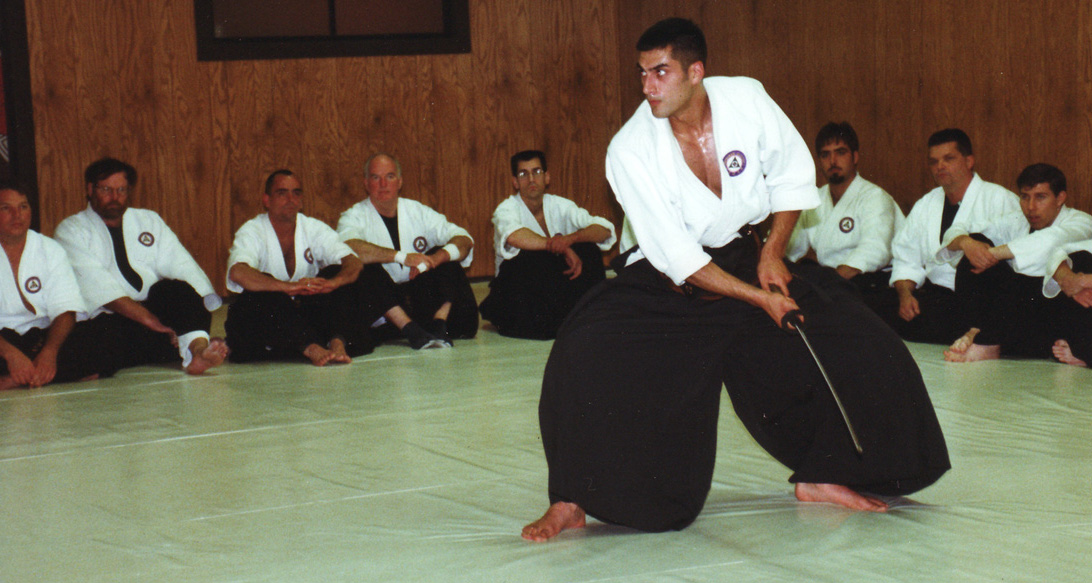
I learned many valuable lessons in that first year of training. The magic of being thrown, repeatedly, against your will. How many thousands of repetitions it actually takes to be able to do such a thing against a resisting opponent. That training is training, and to see past the rose colored glasses that many Westerners don when looking to the Far East for martial arts instruction. Everyone is not a master in Japan, there are no secret techniques. Yes, they do emphasize and applaud good technique in Japan, and culturally honor the warrior spirit. But there was no mythologizing on my part after living there. You can get the same level of technical transmission in the USA, sometimes far better since there's no language barrier, if you train properly under the right instructors.
One art has usually led into the next. I really wanted to study Aikido while I was over there, but it wasn't offered. As I look back on it, I was fortunate to study Judo over Aikido at that early age. Judo is very physical, and conditioning, tenacity, and technique are all required. Lack any one of those and you won't advance, in rank or skill. Of course there are limited rules in Judo, but the intensity is very much like a fight. Plus, I was quite young, and my body healed rapidly. Judo at sixteen is a lot easier than at 26 or 32. Before I returned to Alaska, I had amassed enough tournament victories to receive my shodan, or first degree black belt.
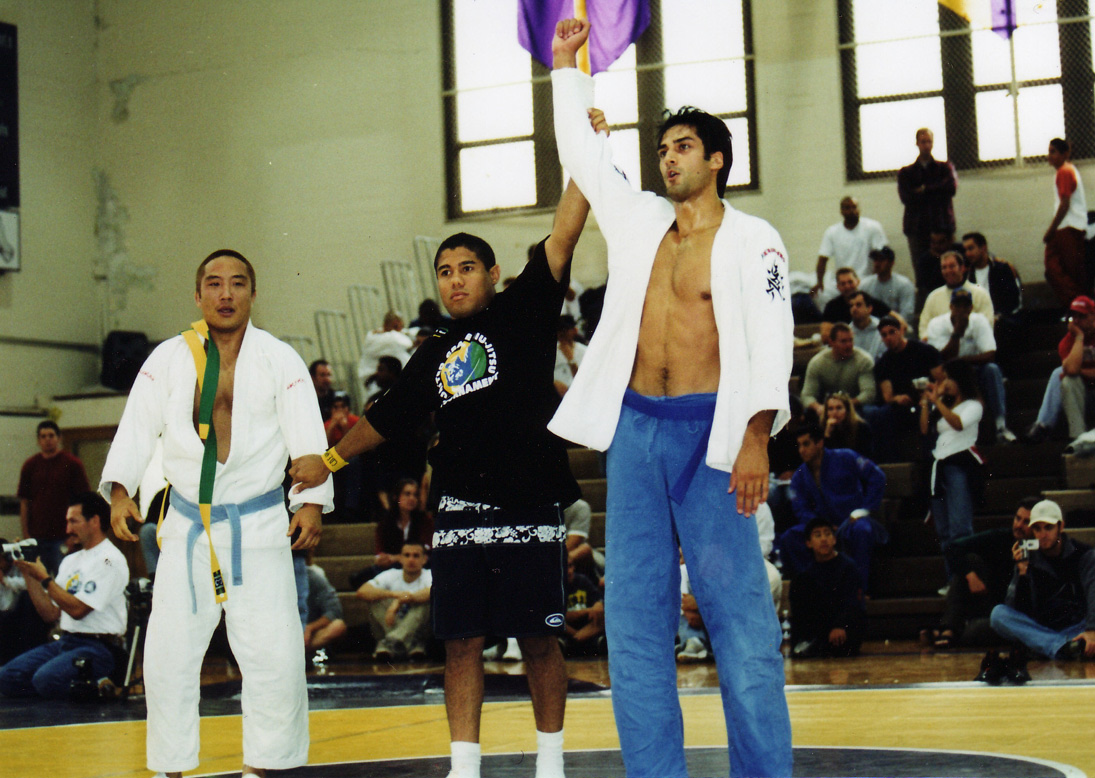
I wanted to continue Judo in Alaska, and did for a short time, but it wasn't the same. With very few high-level practitioners, the frequency of practice wasn't there, plus I had started to realize that wasn't always the range of combat to be involved in. It's hard to throw big guys. I had found some guys I couldn't throw, so what do you do then when that's your one trick?
So I began to study Aikido. Or let me rephrase that: I began to read everything I could about Aikido. I didn't receive academic credit for my year in Japan, so coming back to the USA, I was a year behind my classmates and decided to finish up my last year of high school in Ontario, Canada. There was no Aikido instruction in my specific area, so I essentially memorized everything I could about the art and the stunning feats of its founder, Morihei Ueshiba. While I could have passed a history test on the evolution of Aikido from Daito Ryu Aikijujutsu, all of this reading put an aiki spell on me, without any kind of physical reality check.
I mention this as a warning. Humans have an infinite capacity for self-delusion, and I was convinced that there was some kind of special mojo, or secret knowledge, inherent in the techniques of Aikido that placed it at an echelon above other martial arts. Master Aikido and I could beat anyone. Without "fighting" or getting my hands dirty. I could just redirect their misguided energy like Steven Seagal, as this was his heyday in the movies.
I signed up to study Aikido the day I returned to Alaska. I was beyond dedicated, taking a job with the government basically to support my nighttime training habit. After two years, I decided to take it to the next level and become an uchideshi, or live in student, under Julio Toribio in Monterey, California. Sensei Toribio had founded his own system of Seibukan Jujutsu, based largely on the kata of Hakko Ryu Jujutsu, a sister art of Aikido and another derivative of Daito Ryu. I didn't know much about Seibukan, but as he was a yondan (fourth degree black belt) under Shihan Frank Doran in Aikido, I trusted that he knew what he was doing.
I remained an uchideshi for fifteen months, establishing a live-in student program in that dojo that continued to flourish after I left. I put my heart and soul into training, and stayed for another two years in Monterey. Sensei Toribio is a bit of an icolonoclast. He was an Army Ranger, had done full contact Karate, and definitely knew how to fight. We had a very close relationship, and discussed candidly the efficacy of most Aikido practitioners and instructors. He also allowed me to begin training in Brazilian Jiu Jitsu under Claudio Franca, once a week in Santa Cruz, while still living in the dojo. From a traditional perspective, this is unheard of. Nor has he allowed any of his other uchideshi to adopt a similar pattern. But I was the first, so he made an exception.
I transferred down to UC San Diego to complete my academic studies and left Monterey with a third degree black belt in Seibukan, a black belt in Iaido (the art of drawing the sword), and his first Aikikai Aikido black belt. I continued my martial studies under Roy Harris, dedicating myself fully to Brazilian Jiu Jitsu. By this time, mixed martial arts had gone through several evolutionary cycles, and I realized the importance of training methods and fully resisting opponents. Brazilian Jiu Jitsu had a strong element of martial truth to it, and I was fully addicted.
I don't feel that my time was wasted with any of the arts that I've studied. Judo taught me the importance of repetition, and the warrior spirit it takes to be a fighter. Aikido really helps you develop sensitivity and timing. Iaido doesn't require a partner, and allows you to scrutinize your own movements on a micro level. Seibukan Jujutsu combines strikes with the joint locks of Aikido, plus several that were taken out of the general Aikido syllabus, and encourages adaptation and improvisation. All contribute to my movement, understanding of leverage, and shape my current grappling style.
What is your first recollection of Brazilian Jiu-jitsu? How did this perception jibe with your steeping in traditional Japanese arts? When you started training BJJ was the relative lack of formality at odds with your traditional MA background?
My first exposure to BJJ was Royce Gracie in UFC 2. My friends and I were amazed. With my Judo background, I had some understanding of what he was doing with arm locks and chokes, but my eyes weren't educated enough to really see the brilliance of Royce's strategy, technique, and transitions. I just knew that he was winning. And I liked that. We all liked that. Plus, I had felt the power of grappling arts before, and had no problem understanding positional dominance or the efficacy of submissions.
I actually liked the relative lack of formality in BJJ. At Claudio's, we had a bow at the beginning and end of class, but there were no Japanese terms to memorize, or katas. It was a nice change of pace. Roy Harris' Academy was even less formal. Most classes were done no gi, with handshakes over bows, and the environment was permeated with functionality over form. It was such a breath of fresh air to have an art that rewarded tangible, repeatable skill over hours on the mat or repetition of technical skills without any correlation to fighting ability.
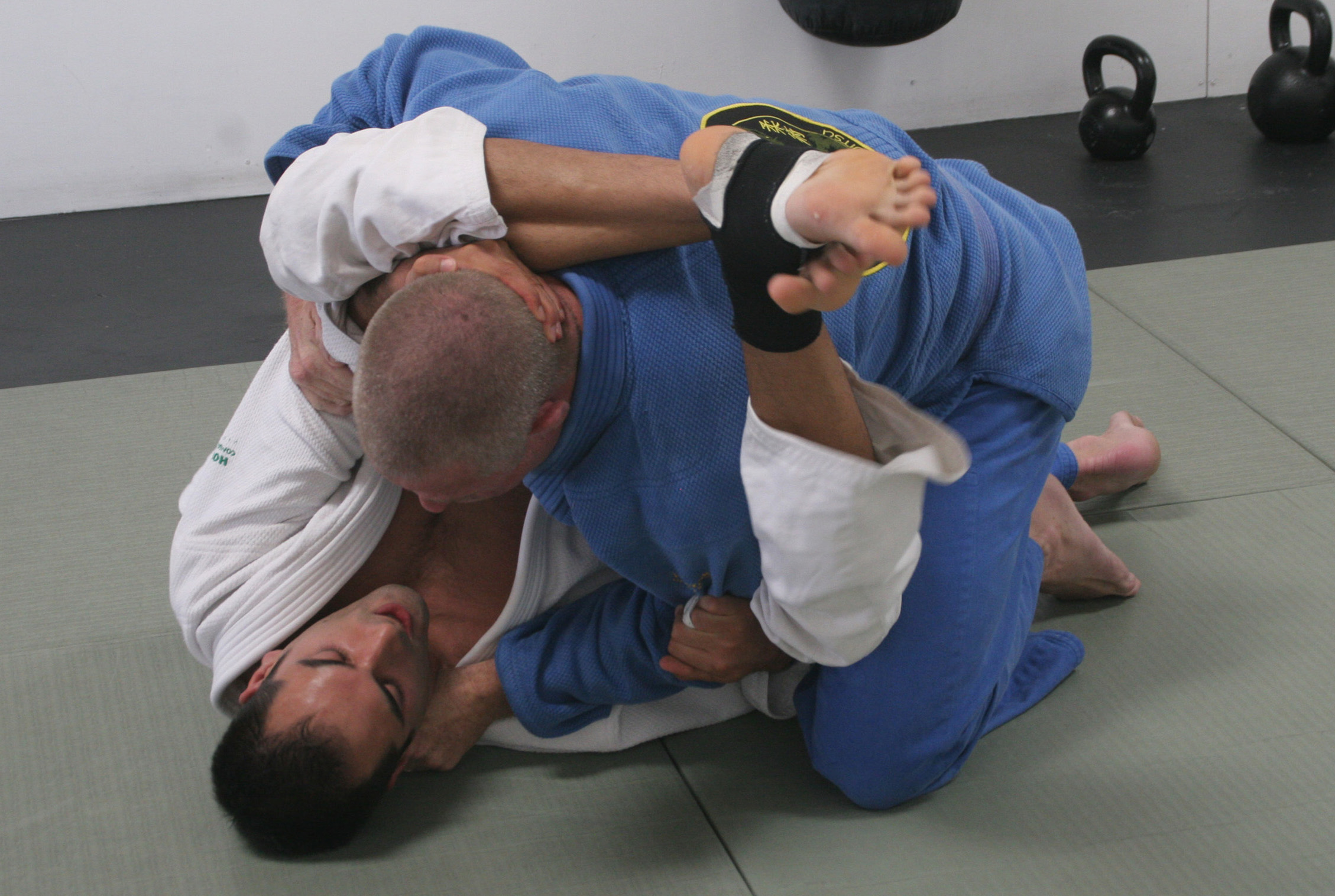
Photo: Alicia Anthony www.aliciaphotos.com
Roy how do you structure your curriculum at the Roy Dean Academy? What elements do you feel are unique to your approach?
Since I have a relatively young school, I have to take a specific approach to instruction, and then adapt that approach over time. Right now I'm focusing on escapes, fundamental movements, and giving them a wide breadth of technical exposure. Over a period of months, as the students become more familiar with ways to escape sidemount, take the back, pass the guard, and apply submissions, I can then build on that awareness. We roll every class, but it's extremely controlled and I'm constantly monitoring. Later it will be more open and free in the sparring, but in a way, I have to save my students from themselves. If they just went at it, they'd probably end up with injuries. That's all too common when there's high enthusiasm and limited technique.
One method that I feel is fairly unique to my teaching method is the way I link techniques together in sequence. For example, I may start with a side mount escape and guard replacement. From there I'll teach a sweep to mount, then a spinning arm lock, followed by an arm lock escape, passing the guard, and a return to side mount. The sequence can then be drilled and repeated. Threading techniques together like this helps the students understand flow, timing, transitions, and systems of techniques that link together strongly. I also tend to emphasize specific techniques over and over again in class, like spinning arm lock from knee on belly. That single technique is a letter in the alphabet, and eventually they can write that letter without thinking, then form short words, and eventually sentences. I also use basic techniques like this as touchstones for student confidence. If I'm showing something new or slightly beyond their grasp, I can bring everyone back on the same page by coming back to that familiar submission, then move on from there.
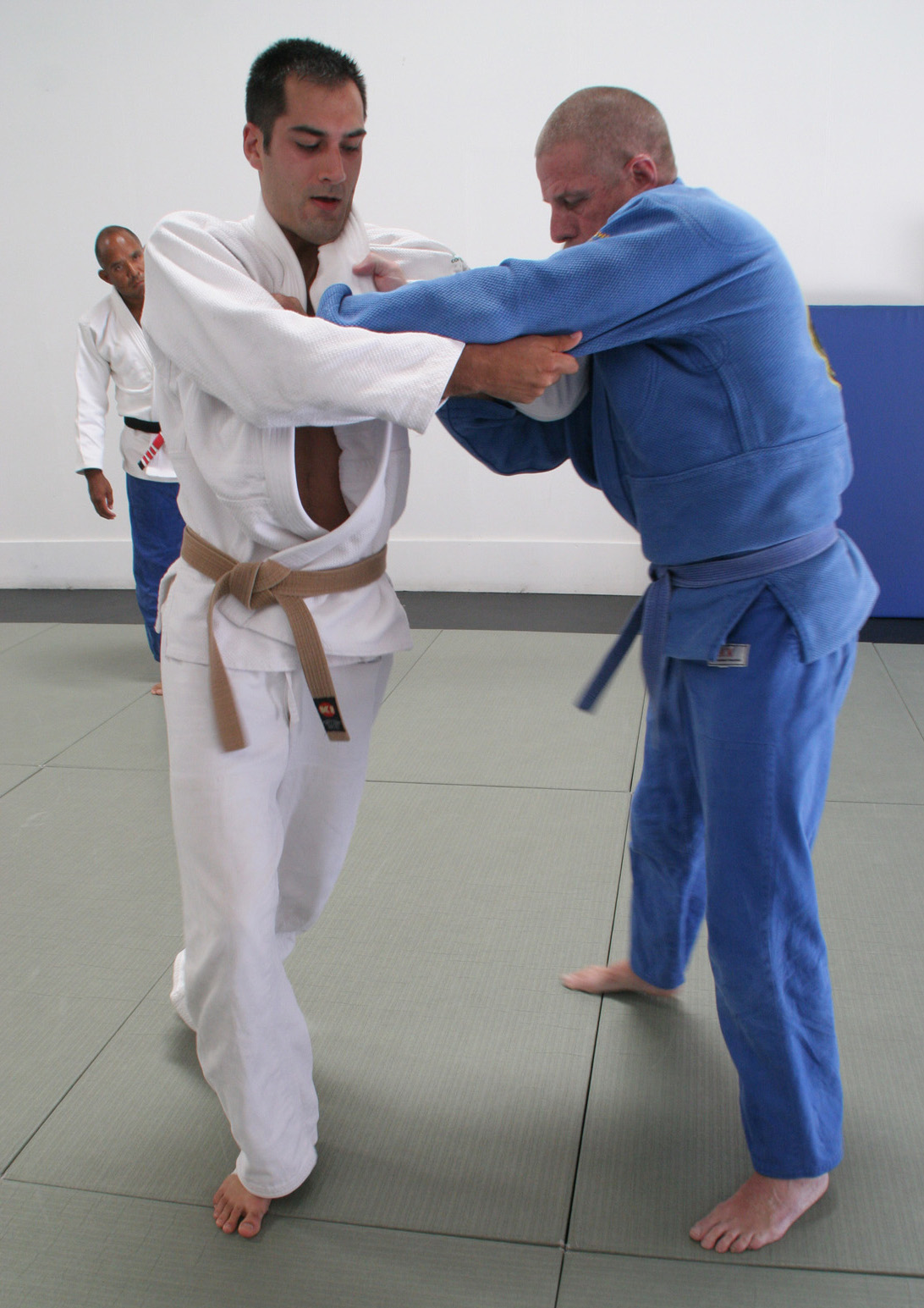
Photo: Alicia Anthony www.aliciaphotos.com
How important is competition for developing a complete game? What are your thoughts on the Gi/No-Gi schism that has arisen in BJJ? Does Gi training have application for the Mixed Martial Artist? If so how does it help the no-Gi or MMA game?
To a limited extent, competition does help round out your game at blue and purple belt levels. It can expose weaknesses (sometimes cruelly) and point out areas in need of improvement. It opens your eyes, and just watching other competitors and the tactics they employ expands your awareness. But after a while, the opposite happens, and your game becomes more and more specialized in competition. Once you've covered up the holes in your game, it allows you to flow more easily to your strong suit, your best positions, and hunt for your bread and butter submissions. Certainly, I can do heel hooks and kimuras, but in competition, it's all triangle and straight arm lock. It's just what comes out. Find the most efficient path for you, and against full resistance, it's usually the safest and smartest path to take. Sometimes it's the only path for survival.
The gi/no gi schism isn't that big of a deal. I train both, and I think every serious jiu jitsu practioner should. Even in the gi, I tend to use no gi leverage points and hand holds, cupping behind the elbows or pushing on the tops of knees, rather than grabbing. Dependency on specific gi grips can be a weakness in other environments.
And I still think the gi training pays dividends in MMA. It allows practitioners to have a more subtle understanding of leverage and off balancing, pushing and pulling, and how to create space with their knees and elbows, without relying on sweat and/or explosiveness. That said, once you have established a foundation with gi training, you probably don't need to ever put it on after purple belt.
What are your thoughts on strength and conditioning and BJJ training? How does one gauge the level of S&C necessary to optimize one’s on-the-mat performance? Does over-reliance on physical attributes slow or halt technique refinement and if so how do you balance the need for a high degree of conditioning with skill development?
I am a realist at heart. Physical conditioning is very important, and techniques without attributes aren't effective. You always need to be strong enough. Strong enough to move yourself in relation to your opponent, but not necessarily strong enough to move them as you wish. There is a difference.
There will always be somebody stronger, faster, younger, more chemically enhanced, or willing to sacrifice a little bit more for short term increased physical capacity, even at the expense of their long term health or joint integrity. Of course I support being in shape, with the capacity for significant power generation, muscular endurance, and cardiovascular stamina. All of these attributes protect you and keep you mentally sharp during training, as extreme fatigue can interfere with your rational mind and leave you vulnerable to injuries.
Learning good jiu jitsu, whether that's aikido, judo, Japanese jujutsu, or BJJ, all require an "undoing" and letting go in your body. If you're too stiff, you're not going to be fast, fluid, or develop the sensitivity to go around your opponent's power. And this is critical. You want to map out the pathways of least resistance, then fuel your movements down those pathways with physical attributes. If your timing is a little off, or the angles not quite right, muscle can act as a lubricant to guide you into the pathway of effectiveness. But if you become overly reliant on that muscle, then you will become disillusioned as you age, as your strength and endurance decrease. On the other hand, sensitivity and timing are attributes you can continue to improve for the rest of your life.
I touched on this a bit above but I’d like to dig a little deeper. What value do the traditional martial arts have in this age of MMA? Is there anything of merit after we get past wrestling, Judo, Thai boxing, Boxing and BJJ? Matt Thornton has made the point that arts that lack alive training (sparring or randori) have a high potential for self deception and the perpetuation of negative characteristics such as paranoia. Do you agree with this? Are arts made better with alive training like that found in Judo or BJJ?
That's a great question. MMA has clearly illustrated the most effective techniques for unarmed, hand-to-hand combat in an ideal environment, where variables are minimized and an individual's fighting spirit and technique are allowed to shine. It has also underscored the necessity of physical conditioning, and finally allows a "put up or shut up" venue for the ki masters and internal stylists and others with grandiose claims. Top level MMA fighters may not be the greatest martial artists in the world, but are DEFINITELY the greatest martial athletes history has ever seen. It is an amazing time to be alive and watch martial evolution unfold within those confines.
Matt Thornton has been a great influence on me, and his philosophy of "aliveness" is something that every serious martial artist should take to heart. I agree with most everything he says, and of course, arts are definitely made better with live resistance and sparring. Plus, I have seen firsthand the negative effects of overconfident and over-ranked practitioners, and the delusional worlds that they live in.
Over the years though, I've realized that people have many reasons for training. Personally, I have always wanted real world effectiveness, so I've always sought to drink from the fountain of martial truth. But that's an arduous journey that not everyone is prepared for, or even wants to make. And there's usually a physical price to pay for it.
Not everyone is ready for that. Some people want to reintegrate into their bodies, or simply discover them for that matter. Some people want the social environment that a training facility provides. Some people want rank over skill, some want skill over rank, and some use their chosen art as a vehicle for personal discovery. So while aliveness is an important concept that is necessary for those seeking to experience the highest level of martial reality, others are unconcerned. Not all who attend church are seeking a powerful and direct experience with God. Some go for the prayers, some for the singing, and some for the doughnuts. If it improves their lives and eases their daily pains, that's fine by me. We're not all on the same level of consciousness, martial or otherwise. I make an effort to not judge, though it's difficult at times. Make the truth available, but don't force others to listen. Live your truth, be a positive role model, and those that are ready will come.
Let's look at traditional arts as mom and pop stores, and mixed martial arts as a Walmart or Target. For most people, a superstore like that has everything they need, or may ever need, and more. CDs, furniture, and Pampers. Perfect. But now and then, they're lacking an item you're looking for, or an electronic connector that would be an elegant and exact fit. Yes, they have general audio cables that could work for your situation, but who needs a six-foot connector when you have a one-foot gap? It's overkill, and you would be much happier if you could just find a perfectly sized one-foot cable. So I think it's critical to support the local mom and pop stores, because there are times when you have to go outside the Big Box to find exactly what you need.
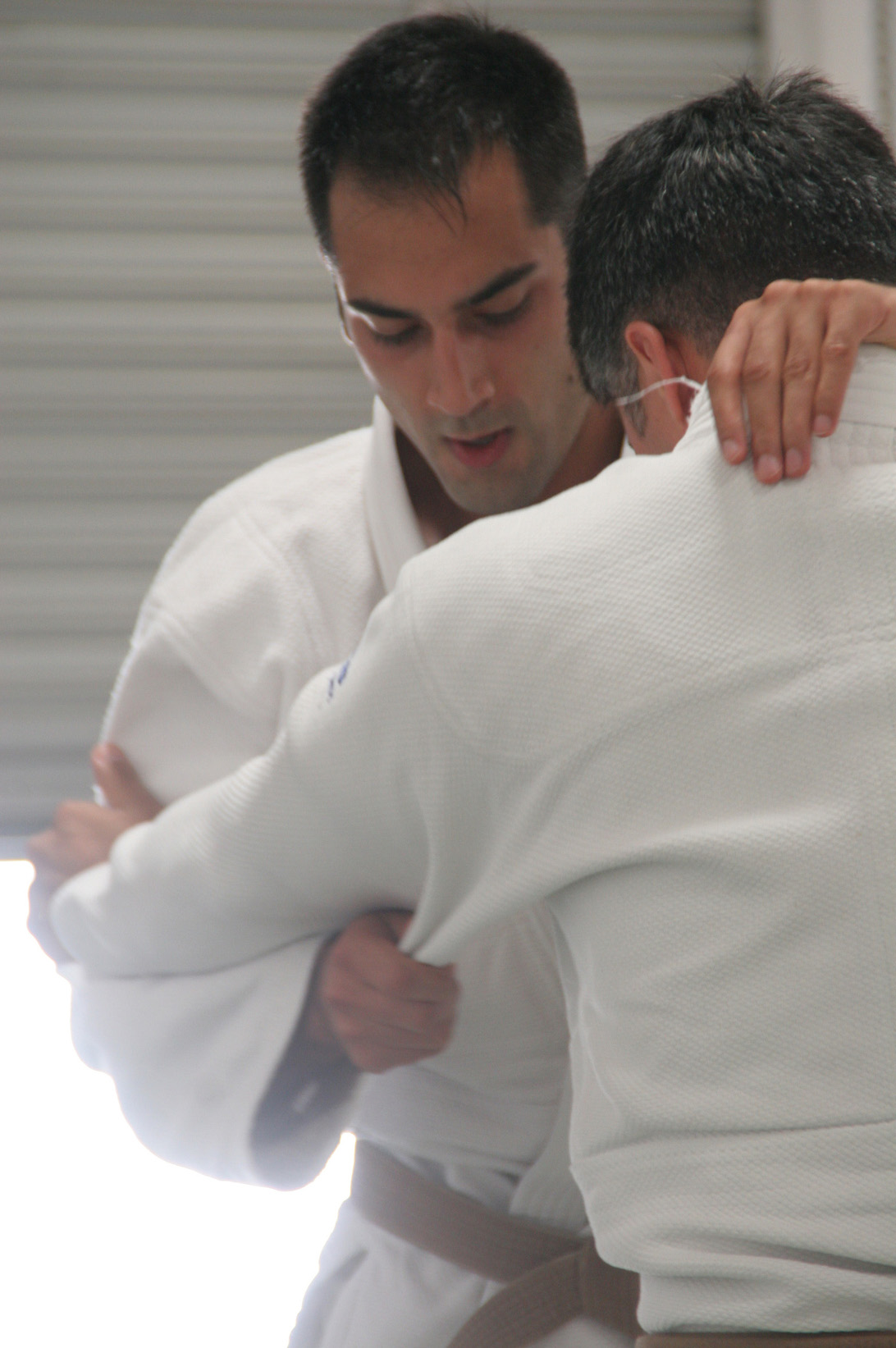
Photo: Alicia Anthony www.aliciaphotos.com
In addition to starting your “brick and mortar” academy, you have been hard at work on a project I think our readers will be very interested in—the E-Journal of Jujutsu: Modern Grappling Quarterly. Tell us how and why you started this, what we will be seeing in the upcoming editions and how to purchase a subscription.
Simply put, I was inspired by online publications such as Performance Menu and CrossFit Journal, and saw the need for a scholarly, high-end martial arts periodical. Of course, there are a slew of grappling and MMA magazines that have come into existence recently, but at best, there might be one or two articles of interest to serious martial arts practitioners, not merely fanboys of the fight world. Half the magazines are ads, half the articles are ads, and they rarely, if ever, ask compelling questions that explored martial philosophy or principles, and genuinely tried to further understanding of interrelated arts.
The aim of the E-Journal of Jujutsu is quite different. We're not shooting for a sixth grade reading level, we're aiming much higher, in terms of both comprehension and content. The likelihood of Black Belt magazine publishing an EJJ article is equivalent to Flex magazine publishing a PMenu exposition on kettlebells and powerlifting. Totally different audience, completely different aims.
Plus, things have come full circle in regards to Brazilian Jiu Jitsu. At one time it was synonymous with mixed martial arts, and while it remains a foundational discipline of MMA, it has assumed its place as another traditional style, no different than Judo or Aikido. Those involved in more "traditional" arts need not fear or deny any elements of martial truth BJJ brings to the table. Just as there are amazing methods of body control and manipulation in other arts that should not fall by the wayside. It's our intention to move the arts forward, and spread well informed perspectives from one pocket of the world to another. We are at a unique time in our history to do so.
The first issue of the EJJ opens with an interview with Irie Yasuhiro, founder of KoKoDo Jujutsu. I have personally received techniques from Sensei Irie and his technique is amazing. Bruce Bookman, a sixth degree black belt in Aikido, Brazilian Jiu Jitsu brown belt, and one of my original inspirations to cross train, writes on the connection between those two arts. Jon Tessier, fifth degree black belt in Danzan Ryu Jujitsu, explores the history of their art's founder, Seishiro Okazaki. Officer Richard North correlates jiu jitsu applications for law enforcement, and more specifically, to hand cuffing techniques. Toxicologist Brad Hirakawa gives the scientific lowdown on the argument for mineral depletion in soils, and the necessity of supplementation for martial athletes. And our second issue is shaping up to be even better, with articles from Roy Harris, Daniel Camarillo, and a pictorial of the Aikido Bridge seminar that recently took place with some of our greatest living Aikido masters.
The first issue of the E-Journal of Jujutsu can be downloaded for free at www.jujutsujournal.com. Registered members will be able to subscribe before the spring issue arrives. We are very excited about this contribution to the field of martial study, with a look and feel unlike anything else I've seen before. With all the gifts and lessons martial arts has bestowed upon me in my years of study, I am honored to finally be able to make a worthy contribution.
Roy recently opened his school, the Roy Dean Academy in Bend, Oregon. I will be forever bitter he did not come to Chico, CA to set up shop, but I guess I will contain my hazing to the phone. Taunting BJJ black belts tends to get ones elbows twisted around in odd directions!
Check out Roy’s blog and near the end of the interview you will find out about a surprise Roy has for us that anyone with an interest in BJJ or martial arts in general will love.

Photo: Alicia Anthony www.aliciaphotos.com
Hey Roy! Thank you again for granting the interview. Please tell the readers a little about yourself: where you grew up, sports you have participated in outside martial arts, school, music background, etc.
Thanks for giving me the opportunity! I grew up in Anchorage, Alaska, and never really integrated into group sports. I was more taken by playing piano as a child and young teenager. I did a little track, some cross country skiing, and weightlifting in high school, but downhill skiing was really my sport of choice until I went to Japan as an exchange student. That's when I began to study Judo.
Some years later, and after several martial arts adventures, I attended the University of California, San Diego. There I studied media arts, specializing in computer music. After graduation, I was hired by a video production company and became their lead audio engineer, mixing TV shows, high-end corporate presentations, commercials, and the like. It was a tremendous opportunity, and I was fortunate to work with some very talented individuals, as well as continue my studies in Brazilian Jiu Jitsu under Roy Harris. After four years of service, and with my BJJ black belt in hand, I decided to launch my own martial arts academy in Bend, Oregon.

How did you begin training the martial arts? What drew you to your first art and how would you describe your journey from those first days to the present? Please describe the arts you hold rank in, what unique features they offer and what they contribute to your present game? Be wordy!
I was sixteen when I served as a Rotary exchange student, and while at my high school I was encouraged to study a Japanese art in their after school club program. Among my choices were Ikebana (flower arranging), Kyudo (Japanese archery), Kendo (sportive fencing), and Judo. Laden with testosterone, Judo was my first choice. They warned me that Judo training was very severe, but since I was having a rough enough time adjusting to the Japanese culture, I threw myself into learning the art.
I was able to fully invest myself in training while I was there. Not only because Judo was a cultural institution embedded in the social consciousness (much like football is over here), but also because I was in sensory overload and had to channel my energy somehow. I was sixteen, away from my friends, in a land where I couldn't speak the language and I couldn't even read the signs! Lots of stimulus going in, but very little going out. Judo helped me channel some of my teenage angst and cultural frustrations.

I learned many valuable lessons in that first year of training. The magic of being thrown, repeatedly, against your will. How many thousands of repetitions it actually takes to be able to do such a thing against a resisting opponent. That training is training, and to see past the rose colored glasses that many Westerners don when looking to the Far East for martial arts instruction. Everyone is not a master in Japan, there are no secret techniques. Yes, they do emphasize and applaud good technique in Japan, and culturally honor the warrior spirit. But there was no mythologizing on my part after living there. You can get the same level of technical transmission in the USA, sometimes far better since there's no language barrier, if you train properly under the right instructors.
One art has usually led into the next. I really wanted to study Aikido while I was over there, but it wasn't offered. As I look back on it, I was fortunate to study Judo over Aikido at that early age. Judo is very physical, and conditioning, tenacity, and technique are all required. Lack any one of those and you won't advance, in rank or skill. Of course there are limited rules in Judo, but the intensity is very much like a fight. Plus, I was quite young, and my body healed rapidly. Judo at sixteen is a lot easier than at 26 or 32. Before I returned to Alaska, I had amassed enough tournament victories to receive my shodan, or first degree black belt.

I wanted to continue Judo in Alaska, and did for a short time, but it wasn't the same. With very few high-level practitioners, the frequency of practice wasn't there, plus I had started to realize that wasn't always the range of combat to be involved in. It's hard to throw big guys. I had found some guys I couldn't throw, so what do you do then when that's your one trick?
So I began to study Aikido. Or let me rephrase that: I began to read everything I could about Aikido. I didn't receive academic credit for my year in Japan, so coming back to the USA, I was a year behind my classmates and decided to finish up my last year of high school in Ontario, Canada. There was no Aikido instruction in my specific area, so I essentially memorized everything I could about the art and the stunning feats of its founder, Morihei Ueshiba. While I could have passed a history test on the evolution of Aikido from Daito Ryu Aikijujutsu, all of this reading put an aiki spell on me, without any kind of physical reality check.
I mention this as a warning. Humans have an infinite capacity for self-delusion, and I was convinced that there was some kind of special mojo, or secret knowledge, inherent in the techniques of Aikido that placed it at an echelon above other martial arts. Master Aikido and I could beat anyone. Without "fighting" or getting my hands dirty. I could just redirect their misguided energy like Steven Seagal, as this was his heyday in the movies.
I signed up to study Aikido the day I returned to Alaska. I was beyond dedicated, taking a job with the government basically to support my nighttime training habit. After two years, I decided to take it to the next level and become an uchideshi, or live in student, under Julio Toribio in Monterey, California. Sensei Toribio had founded his own system of Seibukan Jujutsu, based largely on the kata of Hakko Ryu Jujutsu, a sister art of Aikido and another derivative of Daito Ryu. I didn't know much about Seibukan, but as he was a yondan (fourth degree black belt) under Shihan Frank Doran in Aikido, I trusted that he knew what he was doing.
I remained an uchideshi for fifteen months, establishing a live-in student program in that dojo that continued to flourish after I left. I put my heart and soul into training, and stayed for another two years in Monterey. Sensei Toribio is a bit of an icolonoclast. He was an Army Ranger, had done full contact Karate, and definitely knew how to fight. We had a very close relationship, and discussed candidly the efficacy of most Aikido practitioners and instructors. He also allowed me to begin training in Brazilian Jiu Jitsu under Claudio Franca, once a week in Santa Cruz, while still living in the dojo. From a traditional perspective, this is unheard of. Nor has he allowed any of his other uchideshi to adopt a similar pattern. But I was the first, so he made an exception.
I transferred down to UC San Diego to complete my academic studies and left Monterey with a third degree black belt in Seibukan, a black belt in Iaido (the art of drawing the sword), and his first Aikikai Aikido black belt. I continued my martial studies under Roy Harris, dedicating myself fully to Brazilian Jiu Jitsu. By this time, mixed martial arts had gone through several evolutionary cycles, and I realized the importance of training methods and fully resisting opponents. Brazilian Jiu Jitsu had a strong element of martial truth to it, and I was fully addicted.
I don't feel that my time was wasted with any of the arts that I've studied. Judo taught me the importance of repetition, and the warrior spirit it takes to be a fighter. Aikido really helps you develop sensitivity and timing. Iaido doesn't require a partner, and allows you to scrutinize your own movements on a micro level. Seibukan Jujutsu combines strikes with the joint locks of Aikido, plus several that were taken out of the general Aikido syllabus, and encourages adaptation and improvisation. All contribute to my movement, understanding of leverage, and shape my current grappling style.
What is your first recollection of Brazilian Jiu-jitsu? How did this perception jibe with your steeping in traditional Japanese arts? When you started training BJJ was the relative lack of formality at odds with your traditional MA background?
My first exposure to BJJ was Royce Gracie in UFC 2. My friends and I were amazed. With my Judo background, I had some understanding of what he was doing with arm locks and chokes, but my eyes weren't educated enough to really see the brilliance of Royce's strategy, technique, and transitions. I just knew that he was winning. And I liked that. We all liked that. Plus, I had felt the power of grappling arts before, and had no problem understanding positional dominance or the efficacy of submissions.
I actually liked the relative lack of formality in BJJ. At Claudio's, we had a bow at the beginning and end of class, but there were no Japanese terms to memorize, or katas. It was a nice change of pace. Roy Harris' Academy was even less formal. Most classes were done no gi, with handshakes over bows, and the environment was permeated with functionality over form. It was such a breath of fresh air to have an art that rewarded tangible, repeatable skill over hours on the mat or repetition of technical skills without any correlation to fighting ability.

Photo: Alicia Anthony www.aliciaphotos.com
Roy how do you structure your curriculum at the Roy Dean Academy? What elements do you feel are unique to your approach?
Since I have a relatively young school, I have to take a specific approach to instruction, and then adapt that approach over time. Right now I'm focusing on escapes, fundamental movements, and giving them a wide breadth of technical exposure. Over a period of months, as the students become more familiar with ways to escape sidemount, take the back, pass the guard, and apply submissions, I can then build on that awareness. We roll every class, but it's extremely controlled and I'm constantly monitoring. Later it will be more open and free in the sparring, but in a way, I have to save my students from themselves. If they just went at it, they'd probably end up with injuries. That's all too common when there's high enthusiasm and limited technique.
One method that I feel is fairly unique to my teaching method is the way I link techniques together in sequence. For example, I may start with a side mount escape and guard replacement. From there I'll teach a sweep to mount, then a spinning arm lock, followed by an arm lock escape, passing the guard, and a return to side mount. The sequence can then be drilled and repeated. Threading techniques together like this helps the students understand flow, timing, transitions, and systems of techniques that link together strongly. I also tend to emphasize specific techniques over and over again in class, like spinning arm lock from knee on belly. That single technique is a letter in the alphabet, and eventually they can write that letter without thinking, then form short words, and eventually sentences. I also use basic techniques like this as touchstones for student confidence. If I'm showing something new or slightly beyond their grasp, I can bring everyone back on the same page by coming back to that familiar submission, then move on from there.

Photo: Alicia Anthony www.aliciaphotos.com
How important is competition for developing a complete game? What are your thoughts on the Gi/No-Gi schism that has arisen in BJJ? Does Gi training have application for the Mixed Martial Artist? If so how does it help the no-Gi or MMA game?
To a limited extent, competition does help round out your game at blue and purple belt levels. It can expose weaknesses (sometimes cruelly) and point out areas in need of improvement. It opens your eyes, and just watching other competitors and the tactics they employ expands your awareness. But after a while, the opposite happens, and your game becomes more and more specialized in competition. Once you've covered up the holes in your game, it allows you to flow more easily to your strong suit, your best positions, and hunt for your bread and butter submissions. Certainly, I can do heel hooks and kimuras, but in competition, it's all triangle and straight arm lock. It's just what comes out. Find the most efficient path for you, and against full resistance, it's usually the safest and smartest path to take. Sometimes it's the only path for survival.
The gi/no gi schism isn't that big of a deal. I train both, and I think every serious jiu jitsu practioner should. Even in the gi, I tend to use no gi leverage points and hand holds, cupping behind the elbows or pushing on the tops of knees, rather than grabbing. Dependency on specific gi grips can be a weakness in other environments.
And I still think the gi training pays dividends in MMA. It allows practitioners to have a more subtle understanding of leverage and off balancing, pushing and pulling, and how to create space with their knees and elbows, without relying on sweat and/or explosiveness. That said, once you have established a foundation with gi training, you probably don't need to ever put it on after purple belt.
What are your thoughts on strength and conditioning and BJJ training? How does one gauge the level of S&C necessary to optimize one’s on-the-mat performance? Does over-reliance on physical attributes slow or halt technique refinement and if so how do you balance the need for a high degree of conditioning with skill development?
I am a realist at heart. Physical conditioning is very important, and techniques without attributes aren't effective. You always need to be strong enough. Strong enough to move yourself in relation to your opponent, but not necessarily strong enough to move them as you wish. There is a difference.
There will always be somebody stronger, faster, younger, more chemically enhanced, or willing to sacrifice a little bit more for short term increased physical capacity, even at the expense of their long term health or joint integrity. Of course I support being in shape, with the capacity for significant power generation, muscular endurance, and cardiovascular stamina. All of these attributes protect you and keep you mentally sharp during training, as extreme fatigue can interfere with your rational mind and leave you vulnerable to injuries.
Learning good jiu jitsu, whether that's aikido, judo, Japanese jujutsu, or BJJ, all require an "undoing" and letting go in your body. If you're too stiff, you're not going to be fast, fluid, or develop the sensitivity to go around your opponent's power. And this is critical. You want to map out the pathways of least resistance, then fuel your movements down those pathways with physical attributes. If your timing is a little off, or the angles not quite right, muscle can act as a lubricant to guide you into the pathway of effectiveness. But if you become overly reliant on that muscle, then you will become disillusioned as you age, as your strength and endurance decrease. On the other hand, sensitivity and timing are attributes you can continue to improve for the rest of your life.
I touched on this a bit above but I’d like to dig a little deeper. What value do the traditional martial arts have in this age of MMA? Is there anything of merit after we get past wrestling, Judo, Thai boxing, Boxing and BJJ? Matt Thornton has made the point that arts that lack alive training (sparring or randori) have a high potential for self deception and the perpetuation of negative characteristics such as paranoia. Do you agree with this? Are arts made better with alive training like that found in Judo or BJJ?
That's a great question. MMA has clearly illustrated the most effective techniques for unarmed, hand-to-hand combat in an ideal environment, where variables are minimized and an individual's fighting spirit and technique are allowed to shine. It has also underscored the necessity of physical conditioning, and finally allows a "put up or shut up" venue for the ki masters and internal stylists and others with grandiose claims. Top level MMA fighters may not be the greatest martial artists in the world, but are DEFINITELY the greatest martial athletes history has ever seen. It is an amazing time to be alive and watch martial evolution unfold within those confines.
Matt Thornton has been a great influence on me, and his philosophy of "aliveness" is something that every serious martial artist should take to heart. I agree with most everything he says, and of course, arts are definitely made better with live resistance and sparring. Plus, I have seen firsthand the negative effects of overconfident and over-ranked practitioners, and the delusional worlds that they live in.
Over the years though, I've realized that people have many reasons for training. Personally, I have always wanted real world effectiveness, so I've always sought to drink from the fountain of martial truth. But that's an arduous journey that not everyone is prepared for, or even wants to make. And there's usually a physical price to pay for it.
Not everyone is ready for that. Some people want to reintegrate into their bodies, or simply discover them for that matter. Some people want the social environment that a training facility provides. Some people want rank over skill, some want skill over rank, and some use their chosen art as a vehicle for personal discovery. So while aliveness is an important concept that is necessary for those seeking to experience the highest level of martial reality, others are unconcerned. Not all who attend church are seeking a powerful and direct experience with God. Some go for the prayers, some for the singing, and some for the doughnuts. If it improves their lives and eases their daily pains, that's fine by me. We're not all on the same level of consciousness, martial or otherwise. I make an effort to not judge, though it's difficult at times. Make the truth available, but don't force others to listen. Live your truth, be a positive role model, and those that are ready will come.
Let's look at traditional arts as mom and pop stores, and mixed martial arts as a Walmart or Target. For most people, a superstore like that has everything they need, or may ever need, and more. CDs, furniture, and Pampers. Perfect. But now and then, they're lacking an item you're looking for, or an electronic connector that would be an elegant and exact fit. Yes, they have general audio cables that could work for your situation, but who needs a six-foot connector when you have a one-foot gap? It's overkill, and you would be much happier if you could just find a perfectly sized one-foot cable. So I think it's critical to support the local mom and pop stores, because there are times when you have to go outside the Big Box to find exactly what you need.

Photo: Alicia Anthony www.aliciaphotos.com
In addition to starting your “brick and mortar” academy, you have been hard at work on a project I think our readers will be very interested in—the E-Journal of Jujutsu: Modern Grappling Quarterly. Tell us how and why you started this, what we will be seeing in the upcoming editions and how to purchase a subscription.
Simply put, I was inspired by online publications such as Performance Menu and CrossFit Journal, and saw the need for a scholarly, high-end martial arts periodical. Of course, there are a slew of grappling and MMA magazines that have come into existence recently, but at best, there might be one or two articles of interest to serious martial arts practitioners, not merely fanboys of the fight world. Half the magazines are ads, half the articles are ads, and they rarely, if ever, ask compelling questions that explored martial philosophy or principles, and genuinely tried to further understanding of interrelated arts.
The aim of the E-Journal of Jujutsu is quite different. We're not shooting for a sixth grade reading level, we're aiming much higher, in terms of both comprehension and content. The likelihood of Black Belt magazine publishing an EJJ article is equivalent to Flex magazine publishing a PMenu exposition on kettlebells and powerlifting. Totally different audience, completely different aims.
Plus, things have come full circle in regards to Brazilian Jiu Jitsu. At one time it was synonymous with mixed martial arts, and while it remains a foundational discipline of MMA, it has assumed its place as another traditional style, no different than Judo or Aikido. Those involved in more "traditional" arts need not fear or deny any elements of martial truth BJJ brings to the table. Just as there are amazing methods of body control and manipulation in other arts that should not fall by the wayside. It's our intention to move the arts forward, and spread well informed perspectives from one pocket of the world to another. We are at a unique time in our history to do so.
The first issue of the EJJ opens with an interview with Irie Yasuhiro, founder of KoKoDo Jujutsu. I have personally received techniques from Sensei Irie and his technique is amazing. Bruce Bookman, a sixth degree black belt in Aikido, Brazilian Jiu Jitsu brown belt, and one of my original inspirations to cross train, writes on the connection between those two arts. Jon Tessier, fifth degree black belt in Danzan Ryu Jujitsu, explores the history of their art's founder, Seishiro Okazaki. Officer Richard North correlates jiu jitsu applications for law enforcement, and more specifically, to hand cuffing techniques. Toxicologist Brad Hirakawa gives the scientific lowdown on the argument for mineral depletion in soils, and the necessity of supplementation for martial athletes. And our second issue is shaping up to be even better, with articles from Roy Harris, Daniel Camarillo, and a pictorial of the Aikido Bridge seminar that recently took place with some of our greatest living Aikido masters.
The first issue of the E-Journal of Jujutsu can be downloaded for free at www.jujutsujournal.com. Registered members will be able to subscribe before the spring issue arrives. We are very excited about this contribution to the field of martial study, with a look and feel unlike anything else I've seen before. With all the gifts and lessons martial arts has bestowed upon me in my years of study, I am honored to finally be able to make a worthy contribution.
| Robb Wolf is the author of the best-selling book The Paleo Solution, co-founder of the Performance Menu, and co-owner of NorCal Strength & Conditioning. |
Search Articles
Article Categories
Sort by Author
Sort by Issue & Date
Article Categories
Sort by Author
Sort by Issue & Date

